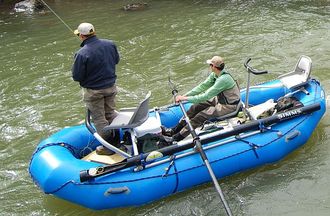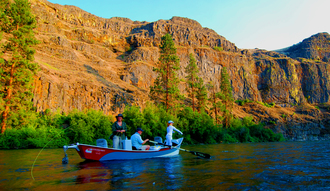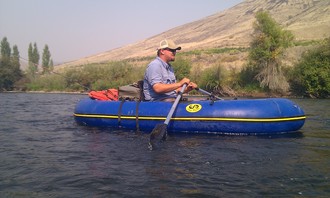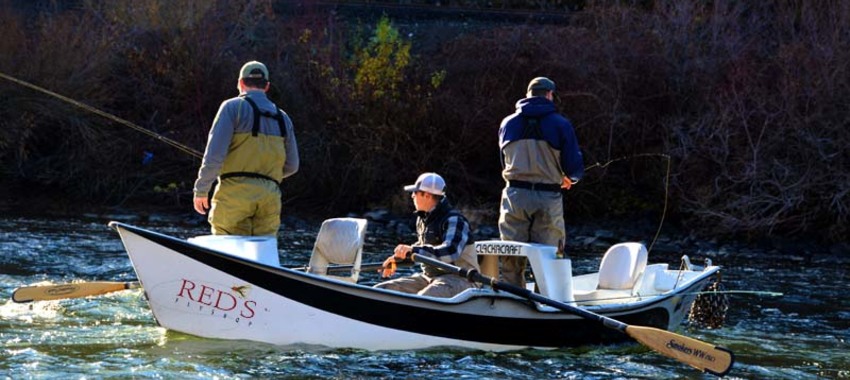14 Critical Tips for DIY River Floats
June 7, 2017
Drifting a river is so much fun in itself, but when you combine it with some fly fishing it becomes an adventure to remember. Let us help you plan, execute, and enjoy your own DIY float trip.
Floating can offer some distinct advantages for anglers that want to cove a bit more mileage or simply get to the other side of the river and expand their fishable water. It can also be the primary source of enjoyment for the day. Piloting your own craft down river with family members or good friends builds teamwork, camaraderie, and since every fish is a team effort each hook-up is celebrated by everyone.
We have a few helpful tips and we invite you to utilize our fishing boat rental services or private rowing lessons.
14 Tips for Rowing Rivers
- Don't worry about the fishing. The #1 priority is getting comfortable with the craft you are rowing.
- Don't get the rods out until you have demonstrated complete control of your boat and are confident that you can avoid danger at a moment's notice. We have seen too many incidents that take place immediately below a put-in that were caused by unhinged enthusiasm. That same passion that got you there can also get you in trouble!
- Double check everything. Secure oar locks, cotter pins, and oar sleeves are essential for a successful trip. If you lose an oar lock... it will be a bad day.
- Secure your gear. Many river boat accidents happen because a rod, net, jacket or other item gets knocked out of the boat and rowers put themselves in unsafe positions trying to retrieve it.
- Favor the inside corners. It is much faster to evade danger going from the inside out, than the outside in.
- Constantly back row to keep the boat moving slightly slower than the current. This helps you feel what the boat is doing and keeps you under control.
- Keep the bow downstream, stern upstream at all times. Try not to angle the boat at more than a 45 degree angle to the current. The boat should be pointed straight up and down river most of the time.
- Anchor only in slower water and avoid large boulders. Your anchor can become lodged while you are in a precarious position and dip a side under water. If this happens, direct yourself and other passengers to the high side of the boat!
- Keep a knife handy. You never know when you might need to cut some rope, straps, or a sandwich.
- Stay away from the bank. In most rivers the dangerous obstacles are along the shore. Logs, brush, and larger rocks are often lurking at the river's edge. Stay in the main channel and avoid contact with the shoreline at all cost.
- Know your float. Get a map, or take a few minutes and drive downstream to get a lookout at your takeout if it's practical. On a new float it is wise to pick ONE landmark 2/3 of the way through the float. Trying to remember every spot and bend is impossible. KISS. Keep it simple stupid.
- Spare oar. Get one.
- Your first few floats should be 80%+ navigation and learning the oars with 20% or less fishing. Get comfortable with your boat and this ratio will naturally swing the other direction in due time.
- Don't be scared. You can do this and we can help!
Additional Video Tips on Rowing River Boat
How Can I Get Started Rowing River Boats?
We are here to help. Here are some ways that Red's can either teach or outfit you on how to safely navigate and "float fish" a trout stream.
3 Types of River Boats

Framed Fishing Rafts offer a combo of a rigid frame and an inflatable raft. They can be equipped with complete anchor systems and even rigid wood floors to stand on. They can host 2-3 anglers at a time and are very safe and versatile. They are perfect for new rowers, portages, whitewater, or if you plan to remove the frame and use it as a paddle raft and put the entire family in it.

Drift Boats are rigid and can be made from fiberglass, aluminum, wood, or even plastic. Most guides row drift boats because they glide upstream well and are very sleek and stable. These are not as forgiving on rocks and can be capsized if you let them run into an obstruction like a large rock or log. We rent drift boats.

Personal watercraft are a great choice for both rivers and lakes. We sell and rent a couple of models that are "frameless" so anglers can easily fit them in the trunk of a car or pack them into a remote fishery. Fishing while floating can be done using fins on your feet to orient the boat, then using oars to cross the river or evade obstacles.
-
Thanks for the tips...NEW raft owner...took your free rising class in early spring... Have used all tips...still on lakes but will venture out on local Cedar River next week...plans to come to Reds and float the Yakima soon.....Thks! Bob
![Reds Fly Shop [logo]](/img/reds-fly-shop/logo.png)
